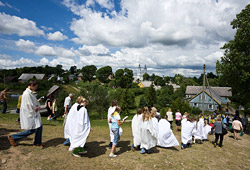History
Written sources first mention Gardai (as Samogitian Calvary was formerly known) in 1253. In 1417, Lithuanian Grand Duke Vytautas (c.1350–1430) donated the land of Gardai to the bishop of Samogitia. A church was built here in 1619, and in 1622 a parish was established. In 1637, Samogitian Bishop Jurgis Tiškevičius (1596–1656) invited the Dominicans. He built a house for them and granted them some land. It was the Dominican friars who built a “Calvary” here: a Way of the Cross with 20 stations commemorating Christ’s Passion, including 19 free-standing chapels. Thanks to this shrine and its annual Mount Calvary Indulgenced Feast, the town itself eventually came to be known as Samogitian Calvary.
From the mid 17th century, Samogitian Calvary gained fame for a miraculous image of Mary and the Child Jesus and a related indulgenced feast of the Visitation of the Blessed Virgin Mary. Petras Pugačevskis, a Dominican, had brought the image of Mary from Rome. The painting’s miraculous nature was recognized formally in 1643, after which the Dominicans built a church in honour of Mary’s Visitation alongside their monastery. A 12-day celebration for the Feast of the Visitation was instituted, and was combined with the already traditional Mount Calvary Indulgenced Feast. In 1649, a small piece of wood from the Cross of Christ was brought from the Dominicans’ Lublin monastery. That relic of the Holy Cross, the largest one in the Baltic States, is still kept here today.
A large, ornate wooden church was built at Samogitian Calvary in 1750, at which time the freestanding chapels were also refurbished or even completely rebuilt. But the steadily increasing popularity of the shrine led the Dominicans to start construction in 1780 of a larger stone church, which was completed in 1822. It was designed by the architect Augustinas Kosauskas (†1803). By order of the Tsarist authorities, in 1889 the Dominican monastery at Samogitian Calvary was closed and a diocesan priest was sent here to tend the pilgrims. The shrine’s church burned down in 1896. It was rebuilt between 1897 and 1902 based on blueprints from the earlier church.
Lithuania won independence in 1918, and within a few years, in 1926, the diocese of Telšiai was created. In 1927, the Marian Fathers took up residence at Samogitian Calvary, where they set up a primary school, worked with young people, restored the chapels and organized retreats and missions in nearby parishes. In 1939, they renovated and painted the interior and exterior of the church. That same year, the 300th anniversary of the shrine‘s establishment was commemorated with great solemnity during the Great Indulgenced Feast of Samogitian Calvary.
Soviet authorities closed the Marian Fathers’ monastery in 1948, and the church became a parish again. The Soviet government did all it could to forbid any public display of religiosity, and threatened to close the shrine’s chapels. But believers managed to keep the church of Samogitian Calvary open, and to prevent demolition of the chapels. The only thing eliminated was the name of the town, which in 1967 was changed to Varduva. Despite the difficulties imposed by the communist authorities, thousands of people from all over Lithuania continued gathering each year for the Great Indulgenced Feast of Samogitian Calvary.
On July 8, 1987, the Jubilee of Lithuania’s Baptism was solemnly celebrated at Samogitian Calvary. On May 6, 1988, the shrine’s church was granted the title of minor basilica. In 1989, the name of the town was changed back to Samogitian Calvary. In the autumn of 2003, the Telšiai Bishop Vincentas Borisevičius Priestly Seminary began to hold its preparatory year for new seminarians at Samogitian Calvary. In 2004, Pope John Paul II established the conditions for gaining a plenary indulgence at the shrine, and gave permission to begin the process of adorning its painting of the Mother of God and Child with papal crowns. Pope Benedict XVI completed the process, and the painting was solemnly crowned on October 8, 2006.








